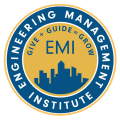In the fast-paced world of architecture, engineering, and construction (AEC), project managers are often expected to deliver clear answers, fast decisions, and flawless execution. But the truth is, the early phases of most AEC projects are anything but clear. In these moments of ambiguity, where information is incomplete and outcomes are still uncertain, ambiguity tolerance in leadership becomes essential. Real leadership begins when leaders can sit with uncertainty and guide others through it.
What separates effective leaders from average ones isn’t just technical expertise or time management — it’s the ability to sit with uncertainty and make space for creativity. And like any leadership skill, this ability can be developed. You can train for it.
The Case for Ambiguity Tolerance
A growing body of research supports what many experienced AEC leaders know intuitively: when you resist the urge to rush through ambiguity, you create room for deeper insight and more innovative solutions.
Leaders who are comfortable not knowing right away frequently arrive at better answers, but only after enduring a bit of productive discomfort. This is the essence of ambiguity tolerance in leadership.
Discomfort Is Not a Signal to Quit — It’s a Sign You’re Getting Stronger
Just like physical endurance training or technical skill building, your ability to lead through ambiguity improves with repetition. Each time you pause instead of forcing a quick solution, you strengthen your leadership capacity.
This kind of discomfort can show up in several ways:
- That awkward silence during a brainstorming session.
- The temptation to fill in gaps with premature decisions.
- The anxiety of telling a client or team member, “We’re still exploring options.”
But over time, your threshold expands. What once felt intolerable becomes a space you can hold with confidence. That’s the mark of a creative problem-solving leader — someone who can navigate the fog of the early phase and guide others through it.
Practical Strategies for Building Your Ambiguity Muscles
The good news? You don’t need to rely on theory alone. Here are four research-supported ways to build your ambiguity tolerance in leadership as a leader in AEC.
1. The ‘Three-Day Delay’ Practice
What it is: When faced with a non-urgent problem, resist the urge to solve it immediately. Instead, jot it down and revisit it three days later, allowing new perspectives to surface.
Why it works: This trains your brain to pause before pouncing on clarity. Ambiguity often resolves naturally when given space, encouraging slow thinking — a core trait of high-performing leaders.
Try it with: vague email requests, complex personal decisions, and unclear feedback.
2. Ambiguity Journaling (5-Minute Daily Prompt)
What it is: Each day, write one paragraph in response to “Whatis unclear to me right now, and how am I reacting to that uncertainty?”
Why it works: Reflection builds metacognition — the ability to notice your own cognitive and emotional responses to foggy situations. Over time, you’ll see patterns in how your discomfort threshold evolves.
Try it with: career decisions, unclear team roles, and performance feedback ambiguity.
3. Build ‘Option Generation’ into Early Project Phases
What it is: During conceptual design, resist locking in a solution. Mandate a three-option minimum exercise with your team — presenting at least three viable paths forward, even if one seems obvious.
Why it works: This forces divergent thinking and models comfort with not knowing the “right” answer yet. It reframes ambiguity as design space, not a leadership failure.
Try it with: scope definition, risk mitigation planning, and alternative delivery models.
4. Run ‘What’s Still Fuzzy?’ Standups
What it is: Once a week, add one question to your standup: “What’s still unclear or in flux for you right now?”
Why it works: This normalizes ambiguity and invites open dialogue, helping PMs surface hidden uncertainty before it causes friction. It signals that not knowing is a shared experience, not a weakness — and builds psychological safety.
Try it with: cross-discipline coordination, client communication gaps, and design-build workflows.
Why This Matters Now More Than Ever
In an industry driven by deadlines, budgets, and tangible outcomes, ambiguity can feel like the enemy. But when you’re equipped to handle it, it becomes an advantage. The best ideas in AEC don’t come from rushing to the answer; they come from leaders who stay in the creative tension long enough to find a truly innovative path forward.
So, the next time you’re in a brainstorm with no obvious solution, remember: you’re not failing, you’re training in decision-making under uncertainty.
References:
- O’Connor, P., Wiewiora, A., & Spark, A. (2024). State Tolerance of Ambiguity Drives Performance and Well-Being Outcomes Within Project Managers: Evidence from a Five-Wave Longitudinal Study. Project Management Journal. Read it here
- Wiewiora, A., & O’Connor, P. (2021). Training Manual for Managing Complexities and Ambiguities in Projects. Project Management Institute. Download the manual
- Wiewiora, A., & O’Connor, P. (2021). Knowing When to Embrace Ambiguity and When to Fear It. Project Management Institute. Read the white paper
- Wiewiora, A., & O’Connor, P. (2021). Helping Project Managers Develop Ability in Managing Uncertainties and Ambiguities in Their Projects.com. Watch the webinar
About the Author: Fiona Johann, PMP, AEC PM

Sources:
AEC PM Certification
AEC PM Connect
Project Management Accelerator™
Engineering Leadership Accelerator™
Keynote Speaking







